Both my kids were day time potty trained within 3 days. I followed the 3 day potty training method and it went incredibly smoothly. No issues at all.
Night time training was completely different.
It took YEARS to night time potty train my older child. The reason for this (which I discovered much later) was because she is an extremely heavy sleeper.
I used to wonder how my sister’s kids who were literally 2 and 3 years old were night time trained but my 6 year old (about to turn 7!) was still wetting the bed.
Today I’d like to share with you EVERYTHING I’ve learnt about night time potty training over the past few years – the do’s, the donts and the 1 trick that finally helped us potty train our deep sleeper.
Night Time Potty Training – 10 Tips You Must Know
This post contains affiliate links. As an Amazon Associate I earn from qualifying purchases.
1. Look for Potty Training Readiness
You’ve probably heard it a 100 times before but I’ll say it again. Every child is different. And every child develops potty training readiness at a different age.
So how do you know your child is “ready” to night time train?
A lo of people suggest looking out for a dry pull up/diaper when your child wakes up in the morning.
It’s said that seeing dry diapers is a huge sign that your child is ready to train.
For some parents however, those dry diapers never come.
I remember I kept waiting and waiting and waiting for those diapers to be dry.
But my 3 year old turned 4 and then 5 and she STILL kept waking up with soggy diapers.
The truth is that if a child has been used to using the diaper as a toilet for all their life, they aren’t magically going to wake up dry unless you start training them otherwise. There are lucky parents out there in the universe who are blessed to get to see their 3 year old wake up with dry diapers. But you should know that isn’t the norm.
The point is to say that you CAN start training a child even if they haven’t been waking up dry.
Here are some signs that can indicate that your child is ready to start night time training:
- Your child has been consistently using the potty during the day with few accidents for at least 6 months.
- They don’t urinate overnight.
- They wake up dry after naps.
- They only wet the bed/diaper/pull-up in the early morning.
- They express a desire to wear underwear to bed.
- They remove their diaper/pull-up by themselves in the morning.
- They don’t need to urinate upon waking, suggesting they’ve already gone in their nighttime diaper.
- They are over 2-3 years old.
If your child shows one or more of these signs, it might be a good time to consider starting nighttime potty training.
2. Start Training At the Right Time
This one can get tricky. What is the “right” time?
There is no clear cut answer on this one (since every child is different) but there are a few guidelines to follow.
Firstly, it is not advised to night time train a child under the age of 2. The “ideal” age is usually between the ages of 2-4 years.
That being said, some kids might still be wetting the bed at the age of 5 (like I said, it can really vary!)
Most kids are fully toilet trained by age 5, but there’s really no target date for having complete bladder control. Between the ages of 5 and 7, bed-wetting remains a problem for some children. After 7 years of age, a small number of children still wet the bed.
The second thing to note is that your child should be day time trained before you start working on night time training.
Some people choose to day/night time train at the same time but that is extremely exhausting for a parent. So I’d suggest you let your child master day time training before you jump into night time training.
The third thing to note: start training at an un-stressful time in your life. If you’re moving houses, having a baby, have guests staying over, are travelling, or any other big thing is happening in your life…wait till things are back to normal before you start training.
3. Get Your Child Excited To Night Time Train
I talk about this all the time when discussing day time potty training.
And the same thing applies to night time potty training. Your child should be EXCITED to train at night and wake up dry. They should feel motivated.
This will play a huge role in your potty training success.
A lot of parents choose to read potty training books with their child. While reading books is a great way to explain potty training to your child, it’s not a hands-on kind of method because it doesn’t involve any participation from your child.
Doing potty training activities is a brilliant alternative because it gets kids involved, engrossed and most of all EXCITED. Check out this Potty Training Activity Booklet in which kids trace, color, match, sort, giggle and laugh as they learn all about potty training the fun way.

4. Use Potty Training Charts and Rewards
Like I said, if you want to see potty training success, you have to get your child motivated. Using a potty training chart can be a great way to keep track of your child’s progress and get them excited.
I have two adorable potty training charts (Dino and Fairy Themed) that you can download, print and start using. FOR FREE.
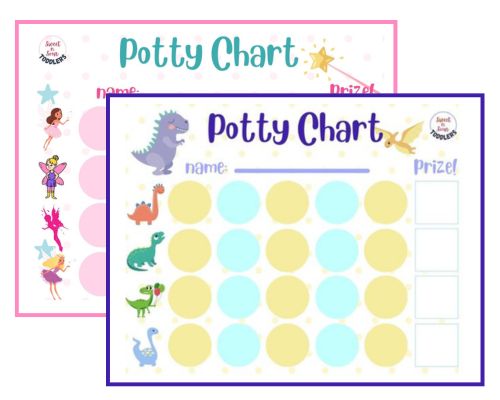
You can also use rewards to get your child motivated to train. Offering a small piece of candy, some MnMs or some chocolate seem to do the trick with most kids.
You can also offer non-sweet rewards. The point is to get your child excited about being dry overnight and ditching the pull ups.
5. No Liquids Before Bedtime
Okay this one is super important. You need to cut back on your child’s liquid intake 2 hours before bedtime. Ideally you should be slowly tapering off the liquid intake as the day progresses.
So you have to make sure that they are drinking plenty of water throughout the day, but as evening approaches, you start reducing the intake. Then, two hours before bedtime you try to have a no-liquid policy in place.
The thing is, this is hard to implement in real life.
My kids would whine and whine about how thirsty they were and I would feel INCREDIBLY guilty for stopping them from being able to drink water!
So I’d give in. Then they’d down TONS of water right before bedtime and the sheets would be soaking wet the next day.
Here’s a solution I found: my kids love yogurt. So I’d tell them that every time they felt thirsty at night, they could have a couple of spoonfuls of cold, creamy greek yogurt.
Yogurt does a great job of removing thirst so this hack worked great for us.
If you’re struggling with a similar issues, try finding a hydrating food that your child likes which can replace the water intake.
6. Ditch the pull ups – sleep without bottoms
It’s important to note that night time training can only happen once you take the diaper off.
If you don’t do that, your child won’t realize that they are wetting themselves.
A key aspect of staying dry overnight is developing a neurological connection between the bladder and the brain. When the bladder is full, it should signal the brain that it’s time to empty.
This can be harder for a child to respond to while asleep, but it is a skill that can be learned. Having your child sleep without bottoms can increase their awareness of accidents and help trigger them to wake up.
Pull ups and training pants have the same absorbant texture as a diaper so don’t use while night time training.
7. Potty Trips Before Bed
Get your child into the habit of using the bathroom right before they head to bed. This habit helps reduce chances of accidents. Have one trip to the bathroom 30 minutes prior to bedtime and another trip right before bedtime.
8. Make it Easy To Use The Bathroom
To minimize sleep disruption, ensure your child has quick and easy access to the potty. I
You can choose to place a potty chair like this one in their room if the bathroom is too far from their room.
If not, make sure they can reach the nearest bathroom on their own.
Both options should be softly lit with a nightlight—enough to see, but not enough to fully wake your child. Keeping a potty close to the bed allows your child to quickly return to sleep after using the potty at night.
9. Have your supplies ready
You have to make sure that you have your night time training supplies BEFORE you begin training.
If you don’t have these supplies from before, you will head into potty training feeling extremely frustrated and overwhelmed.
Nighttime potty training a heavy sleeper can be a daunting task. Here are seven must-have items to ease the process:
1. High-Quality Waterproof Mattress Protectors
I literally swear by mattress protectors.
Night time training with your sanity intact is NOT possible without these.
I’d say purchase at least two, ideally four of these waterproof mattress protectors to handle frequent washes.
We purchased this mattress protector , and it is holding up great to daily washings. Just dry them on low heat to preserve the waterproof barrier.
You can choose to get the cheap $10 ones (I’ve tried them and they are a total waste of money!).
It’s much much wiser to get the high end, good quality ones that are absorbant and do the task of protecting the matress from leaks (scrubbing pee out of a mattress at 3 am is not fun…just saying)
Buy the good ones and take good care of them!
2. Extra Sheets and Blankets
Double-layer your child’s bed for easy middle-of-the-night changes and keep extra sheets ready. Using only bottom sheets and blankets can simplify the process.
3. Additional Laundry Baskets
Have good quality laundry baskets on standby. There will be lots of accidents and you need to be prepared.
No one wants to toss smelly sheets on to the bedroom floor in the middle of the night.
Multiple baskets can be very helpful, especially for larger families.
4. Extra Underwear and Pyjamas
Ensure your child has plenty of underwear and pyjamas to get through the training period.
Durable, comfortable options are crucial, and gender-neutral colors are great for hand-me-downs.
5. Nightlight for the Bathroom
An LED nightlight in the bedroom or a cute toilet night light like this one can make nighttime trips less disruptive and easier for your child.
6. Disposable Mattress Pads
Use disposable mattress pads like these for times when you need a break from constant laundry. They are convenient during tough nights and can be easily managed by your child.
7. Caffeine (For You)
Prepare for interrupted sleep by stocking up on your favorite caffeine source. A reliable coffee maker (we love this one!) can make those early mornings more manageable.
By having these essentials on hand, you can better navigate the challenges of nighttime potty training and support your heavy sleeper through the transition.
10. Potty Training a Heavy Sleeper – What Finally Worked
Here’s the thing. I used all the above tips and they worked for one of my kids but not the other.
Like I mentioned earlier, my older one was a very heavy sleeper. I tried ALL the above tips but she kept wetting her bed.
When she was 5, I didn’t worry about it too much. But when she was 6 (about to turn 7) and she was STILL wetting the bed every night, I started to panic.
What was I doing wrong?
I researched everything I could about bed wetting at night time.
This is what I discovered. Children who are heavy sleepers are MUCH harder to night time train.
My child was a heavy sleeper. This meant that it was really hard for her to even realize that she was wetting herself at night.
Her brain and bladder were not making the connection.
What was the solution?
From what I read, bedwetting alarms had the highest rate of success.
I had never HEARD of a bedwetting alarm before and was super sceptical about getting one or using one with my child.
But I was just so maxed out and nothing else was working. My child was 6 and no matter how much I reduced her liquid intake at night, she still woke up soaking every day.
I WAS SO TIRED OF DOING SO MUCH LAUNDRY EVERY DAY.
I decided to bite the bullet and try out a bedwetting alarm.
This is the one that I got after much research and deliberation. (it wasn’t expensive at all and it worked exactly as it was supposed to!)
And the results ASTOUNDED me.
After exactly 9 days of using this alarm, my 6 year old was fully night time trained. Like 100% trained. She never had a single accident after those 9 days of using that alarm. Pretty cool, huh?
So how do bedwetting alarms work and why are they such a great option for children who are heavy sleepers?
How do bedwetting alarms work?
Bedwetting alarms function through behavioral conditioning, training the brain to respond to signals from the bladder to prevent bedwetting during sleep.
Typically, the sensation of a full bladder should wake a child, but for bedwetters, this doesn’t happen.
These alarms are equipped with moisture sensors that trigger a sound to wake the child, allowing them to go to the toilet and finish urinating. The goal is to establish a mental connection between the feeling of a full bladder and waking up, so the child eventually learns to wake up on their own and go to the bathroom without needing the alarm.
Using A Bedwetting Alarm for 9 Days – Process And Results
Okay so I want to give you an idea of how our 9 days looked like when using the Wet-Stop Bedwetting Alarm.
Firstly, I prepped my child about the alarm. I got her excited about how we’d use the alarm to finally get night time trained. Then I explained how everything worked.
The part with the sensor was clipped on to her panty. The other end of the alarm was clipped on to her shirt. She was totally comfy and had no issues about having the alarm clipped on. In fact, it looks like a pretty cool little device so she was fascinated and excited to be using it.
Next, I let her know that when she would pee at night, the alarm would ring very loudly.
On day #1, the alarm sounded and both my daughter and I woke up with a startle. The sound of the alarm was very loud. She was totally drenched in pee. I took her to the bathroom and cleaned her up, cleaned up the bed and re attached the alarm. The alarm rang for the second time in the night and she was soaking wet with pee again.
The next day, the same thing happened except the alarm only rang once.
On day #3, the exact same thing happened except this time, she held in a little bit of the pee and finished doing it on the toilet seat.
On day #4, the same thing happened except this time, again, she held in a little bit of the pee and finished doing it on the toilet seat.
On day #5, by the time the alarm rang, she had held in about 50% of the pee. So the remaining pee that she had to do, she did it on the toilet seat after the alarm woke her up.
Day #6- day #8 the same thing happened – with each passing day, she was holding in more and more of her pee. By the 8th day, only a few drops of pee came on her panty and the rest of the pee she did on the toilet seat.
On day #9, the alarm did not ring at all – she was totally dry in the morning!!!
I thought it was too good to be true!
On day 10 and 11 I continued to use the alarm but again, it didn’t ring. She was totally dry in the morning!
On day#12 something happened – she woke me up and told me she had to use the bathroom. My heavy sleeper woke up HERSELF and went to the bathroom from the sensation of a full bladder!
After 9 days of using the Wet-Stop Bedwetting Alarm, she never had a single night time accident ever again!
Here are The Key Takeways
- Many children can achieve overnight dryness sooner than we might think! You don’t need to wait until you see dry diapers before you start night time training
- Get your child excited about training – use reward charts and potty training activity sheets to create excitement
- Using disposable diapers and pull-ups may delay nighttime dryness, so removing them can speed up the process.
- If your child is ready for nighttime potty training, consider steps like limiting fluids before bed, encouraging them to use the toilet twice during their bedtime routine, and keeping a small potty easily accessible in their room.
- Remember, accidents are normal! Even after successful nighttime potty training, occasional bedwetting is common and usually nothing to worry about
- It’s harder to night time train heavy sleepers
- If your child is older than 5 and is still bed wetting, a bedwetting alarm can be a fantastic tool to help develop their brain-to-bladder connection
This post was about night time potty training
We think you’ll enjoy reading these posts next:
15 Steps to Potty Train a Stubborn Toddler Girl in 3 Days
20 Genius Potty Training Reward Ideas (that seriously work!)
15 Clever Tips for Leaving the House While Potty Training
20 Insanely Fun Potty Training Activity Sheets for Toddlers
12 Genius Hacks to Make Potty Training Less Stressful
10 Truly Awful Potty Training Mistakes You Should Know About

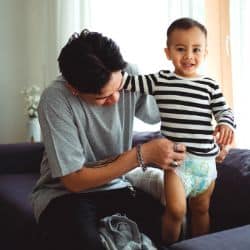
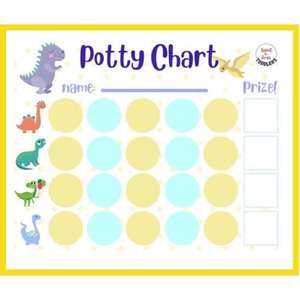
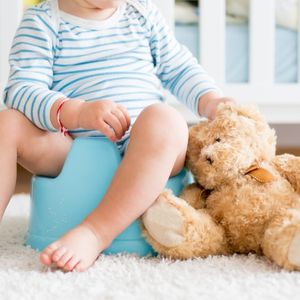
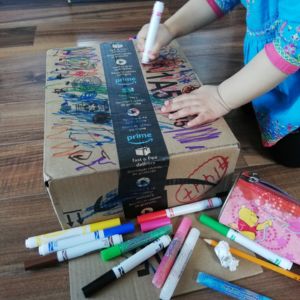
Leave a Reply